Part 1 /5
Yemen Papers
A leak of classified French defence ministry documents, revealed here, details the massive use of French-made weapons in the ongoing, four-year-old war in Yemen.
“Minister, I have a question which is going to annoy you.” The warning came during a January 20th 2019 interview on French national radio station France Inter with France’s defence minister Florence Parly.
Interviewer Ali Baddou stared at the minister and, raising his voice slightly, asked: “Should there be a halt to weapons sales to Saudi Arabia?”
It was a subject that had been asked over several months, but which had met with no official response. Yet the issue of arms contracts between France and Saudi Arabia is part of a demanding moral, political and legal debate: should France supply weapons to a client who has been using them, over the past four years, to bomb civilians in Yemen?
On March 26th 2015, at the head of a coalition with the United Arab Emirates (UAE) and eight Arab states with a majority Sunni Muslim population, Saudi Arabia’s Crown Prince Mohammed bin Salman ordered a series of attacks by air and sea against targets in Yemen. The objective was to defend the ruling Yemeni regime against a military offensive launched by the country’s Houthi movement, from Yemen’s Shia Muslim minority, and which is supported by Iran.
Today, the country is gripped by what the United Nations (UN) has described as “one of the worst humanitarian crises in the world”. Many among Yemen’s population of more than 28 million continue to face aerial bombing raids by the Saudi-led coalition which, according to statistics from the Yemen Data Project, an independent NGO that researches and cross-checks data on coalition strikes, have already killed more than 8,300 civilians, including 1,283 children.
On March 26th 2015, Saudi Arabia, at the head of a coalition of ten Arab countries, launched a military offensive in Yemen. Its purpose was to crush the armed rebellion of the Houthi movement that champions Yemen’s minority Shia Muslim population, and which is supported by Iran.
Today, the Arab coalition is made up of only four countries: Saudi Arabia, the UAE, Sudan and Bahrain.
In red on the map, areas controlled by the Houthis.

A district of Sanaa, the capital of Yemen, May 27th 2018.
Photo: Lorenzo Tugnoli.
During the January 20th 2019 France Inter interview with France’s defence minister, Ali Baddou continued: “Can you tell us, Florence Parly, if French weapons have been used against civilians in Yemen?”
The minister, placing her hands flat on the table before her, ended the questioning with the single comment: “I have no knowledge as to whether [French] weapons are being used directly in this conflict.”
Disclose has been given access to classified French official documents, which come under the term “Confidentiel Défense”, the first level of classified “Secret défense” documents in France relating to officially protected information on military matters. The documents, contained in a 15-page report authored by officers from France’s military intelligence agency, the DRM, are dated September 25th 2018.
The report, entitled “Yémen - situation sécuritaire” (“Yemen – security situation”) was submitted to French President Emmanuel Macron and his defence minister Florence Parly. It was also submitted to the French prime minister’s office and to French foreign affairs minister Jean-Yves Le Drian, on the occasion of a select defence council meeting on the war in Yemen which was held at the French presidential office, the Élysée Palace, on October 3rd 2018.
The leaked DRM report, illustrated with maps and graphics, reveals here for the first time what the French government has thus far attempted to conceal, namely a detailed list of French weapons that are part of the arsenal employed in the conflict in Yemen.
These include Leclerc battle tanks, long-rod penetrator ammunition, Mirage 2000-9 fighter jets, COBRA counter-battery radar systems, Aravis armoured troop-carrying vehicles, Cougar and Dauphin helicopters, and CAESAR truck-mounted howitzers. The report precisely details each model, and indicates whether the equipment was sold to Saudi Arabia or its coalition partner, the UAE. Above all, it reveals that a number of French-made weapons are being used in combat operations in Yemen, including in civilian zones.
The leaked DRM report reveals, here for the first time in public, the list of French weapons used in the war in Yemen.
The CAESAR gun is a star product of the French weapons industry, manufactured in the town of Roanne, in central France, by Nexter, an arms manufacturer entirely owned by the French state. The howitzer, mounted on an all-wheel-drive truck chassis, can fire six shells per minute onto a target up to 42 kilometres away. According to Nexter’s presentation brochure, the gun has a “firepower that is heightened by the rapidity with which it can be set up, its lengthened range and its great precision”.

CAESAR howitzer on the border between Yemen and Saudi Arabia in June 2018.
Since 2010, France has sold 132 CAESAR howitzers to Saudi Arabia, according to the Stockholm International Peace Research Institute (SIPRI), an independent Swedish body dedicated to research into conflict, armaments, arms control and disarmament. Further deliveries of the weapon are due over the coming months (see “The itinerary of a secret weapons shipment”).
The DRM report includes a map entitled “Population under threat of bombs”. This shows where 48 CAESAR guns are positioned close to the Saudi-Yemeni border, their turrets facing three different zones in Yemen, in which are located towns, villages, farms and farmers’ hamlets.
On the map, around the locations of the CAESARs, are circles, drawn in red, which show the range of the guns, and which touch on inhabited areas.
Are these habitations the target of the French-made guns? The answer is found on page 4 of the report given to President Macron, where it notes that the CAESARs “back up loyalist troops and Saudi armed forces in their progression into Yemeni territory”. Put more simply, the guns are used to bombard Yemeni territory to open up a path for the tanks and armoured vehicles invading the country.

On September 25th 2018, the Saudi Arabian army had 48 CAESAR howitzers positioned at the border with Yemen.
The DRM report precisely noted: “The population concerned by potential artillery fire: 436,370 people.”
We have studied data from the NGO Armed Conflict Location & Event Data Project (ACLED) on the numbers of civilian deaths from artillery fire that were within firing range of CAESAR howitzers employed in the Yemen conflict.
This showed that between March 2016 and December 2018, a total of 35 civilians were killed in 52 bombardments localised within the range of the CAESARs.
Over the past four years, several NGOs have closely monitored the course of the war, and notably its consequences upon the civilian population. One of them is the US-based Armed Conflict Location & Event Data Project (ACLED) whose researchers study and cross-check information from Yemeni media sources and websites reporting bombing offensives.
The country’s principal news agency, the Yemen News Agency, reported that on June 14th 2018, Saudi “artillery fire” in the north of the country left two children dead and several adults wounded. The report was cross-checked by ACLED. The site of the artillery bombing was the village of Bani Faid, in the Midi district, which was in range of the French-made CAESAR guns. Artillery weapons made in the US, Britain and China are also employed to shell targets in northern Yemen, but according to the DRM report, the village was not within their range.
On August 25th 2018, another incident of “coalition artillery fire” targeted a location close the town of Harad (22,000 inhabitants). A house was destroyed, killing one person and wounding three others. The position of the location on the DRM map shows it to be within range of the CAESARs deployed on the Saudi side of the border with Yemen.
There were more civilians wounded, and buildings damaged, in shelling on April 28th 2018 of Al Mazraq and the village of Al Atn, close to the Saudi border in the same region of northern Yemen where, according to the DRM map, only the range of the CAESAR guns can threaten the population.
What about other French-made weapons used by Saudi Arabia and the UAE? Speaking before the defence affairs committee of France’s lower house, the National Assembly, in July last year, defence minister Florence Parly said: “To my knowledge, land-based equipment sold to Saudi Arabia is used not for offensive means but for defensive purposes at the border with Saudi Arabia.” That implied that French-made tanks and guns are used inside Saudi Arabia to protect the kingdom from Houthi attacks. But what the minister presented as a “defensive” war is not that which is detailed in the DRM report.
According to the military intelligence agency, 70 Leclerc-type tanks are employed in the conflict. Of these, the UAE army has reportedly grouped around 40 in military camps at Mocha and Al-Kwakhah, on Yemen’s western coast. According to the DRM, those tanks largely remain within their bases and have never been “observed on the front line” of the fighting. Never? The report adopts an important nuance: “They are nevertheless deployed in the zone of Al-Khawkhah, at 115 kilometres from Hodeidah.”
According to our study of images recorded on the frontline, and matched against satellite images, the Leclerc tanks have taken part in several major coalition offensives.
One of these was on Yemen’s western coastal region, over the period between June and December 2018. The Leclerc tanks left their bases and travelled along a route north, passing by the town of Al-Khawkhah and the historic town of Zabid. They were heading for Hodeidah, a port city controlled by Houthi forces since 2014. It is Yemen’s principal hub for imports of essential produce, such as wheat, rice and sugar, and as such a priority military objective for the coalition.

French-made Leclerc tanks sold to the United Arab Emirates.
The DRM has identified four zones in Yemen where the French-made tanks are deployed.

Contrary to what Florence Parly had suggested, the Leclerc tanks are used in combat. The DRM detailed that they “only employ French munitions”, which is long-rod penetrator ammunition. The following video shows Leclerc tanks on the road to Zadib.
In October 2018, the French-made tanks rolled in the direction of Hodeidah. We found a video shot by Yemeni military personnel supporting the Saudi-led coalition.
In November 2018, the French-made tanks were at the centre of the battle for control of Hodeidah. According to ACLED, they were responsible for 55 civilian deaths. We found a video shot by the Yemeni military supporting the coalition.
Disclose has identified on satellite images the presence of Leclerc tanks, on November 11th 2018, close to habitations located five kilometres from Hodeidah.
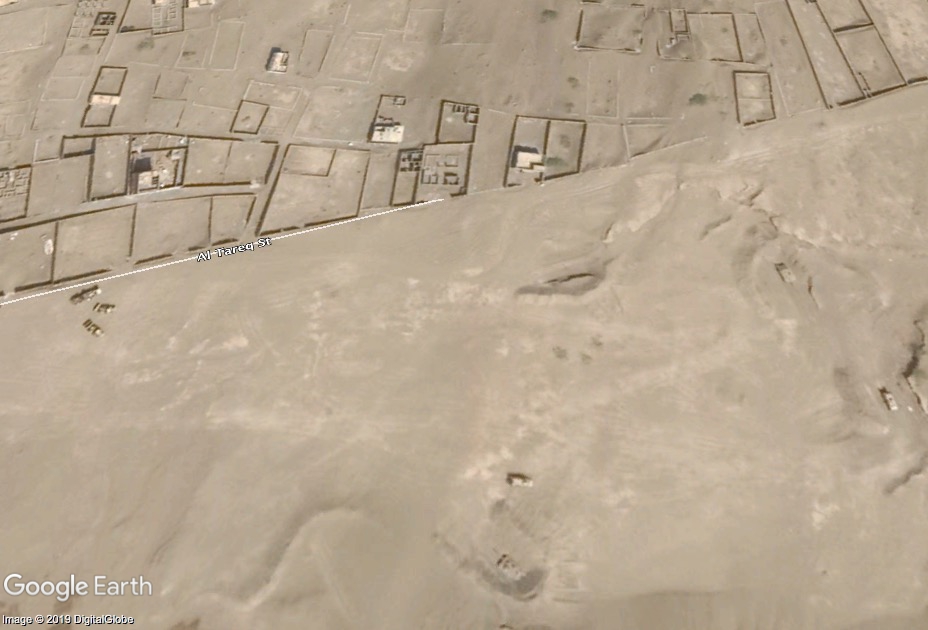
The most devastating attacks by the coalition are air raids. In their report, the French military intelligence officers noted: “Since March 2015, Riyadh has led a campaign of massive and continued aerial bombings.” According to the DREM, the coalition has carried out 24,000 air raids since 2015, including 6,000 in 2018.
“Action by Saudi Arabia is essentially carried out by air,” commented French foreign affairs minister Jean-Yves Le Drian, speaking on February 13th 2019 before the foreign affairs commission of France’s National Assembly.
He dismissed any French responsibility in the attacks. “We supply nothing to the Saudi air force,” he insisted. But that was not true, as demonstrated by the DRM report which, while the parliamentarians had no knowledge of its existence, Le Drian had already received on his desk four months earlier.
The DRM documents detail precisely that Saudi fighter-bomber aircraft are equipped with a technological marvel designed and maintained by French engineers. This is the pod Damoclès, a high performance, long-range targeting pod made by French defence group Thalès, which, fixed to the underside of an aircraft, allows pilots to guide by laser any type of missile onto its target.

A Saudi Tornado plane equipped with a Damocles pod.
It can even be used to steer missiles from the US defence firm Raytheon. According to an investigation by news channel CNN, shrapnel from a Raytheon laser-guided missile was found beside the wreckage of a vehicle destroyed on September 20th 2016 in the north Yemeni district of Al-Mutama. The attack reportedly killed 15 people, 12 of them children.
An indispensable tool for targeted bombings, the pod Damoclès is also used by the UAE air force on its French-made fighter planes, such as the multi-role Mirage 2000-9 which, it is established, “operates over Yemen”. Just what missiles the jets use is not mentioned in the DRM report. But what it does detail is that the Emirati air force bought guided missiles co-developed by France and the UK called Black Shaheen (manufactured by multi-national defence firm MBDA), along with AASM missiles (manufactured by French firm Safran), both of which can be used on the Mirage 2000-9 deployed over Yemen. The UAE has a fleet of 62 fighter-bombers, according to SIPRI, an independent Swedish institute dedicated to research into conflict, armaments, arms control and disarmament.
According to the DRM, the Saudi-led coalition carried out 24,000 air strikes since 2015 and, according to the Yemen Data Project, these caused more than 8,300 civilian deaths.
The UAE’s French-made fighter-bomber jets carry out offensive missions in Yemen from their base in Assab, a Red Sea port city in Eritrea, on the African continent. On the satellite view, we spotted 3 Mirage 2000-9s in February 2018.

Three Mirage 2000-9s stationed on the Assab military base in February 2018.
Other French-made air attack weaponry is directly involved in the war in Yemen. This includes the Cougar combat helicopter which transports Saudi troops. There is also the A330 MRTT re-fuelling tanker aircraft, built by the France-based consortium Airbus, which has delivered six of the tankers to Saudi Arabia, and three to the UAE. These nine air-to-air refuelling and transport planes play a key role in the conflict, capable of simultaneously refuelling mid-flight several of the coalition combat planes.
The Airbus A330 MRTT tanker aircraft operate from their Saudi Arabian base at Jeddah. They refuel coalition aircraft in mid-flight.
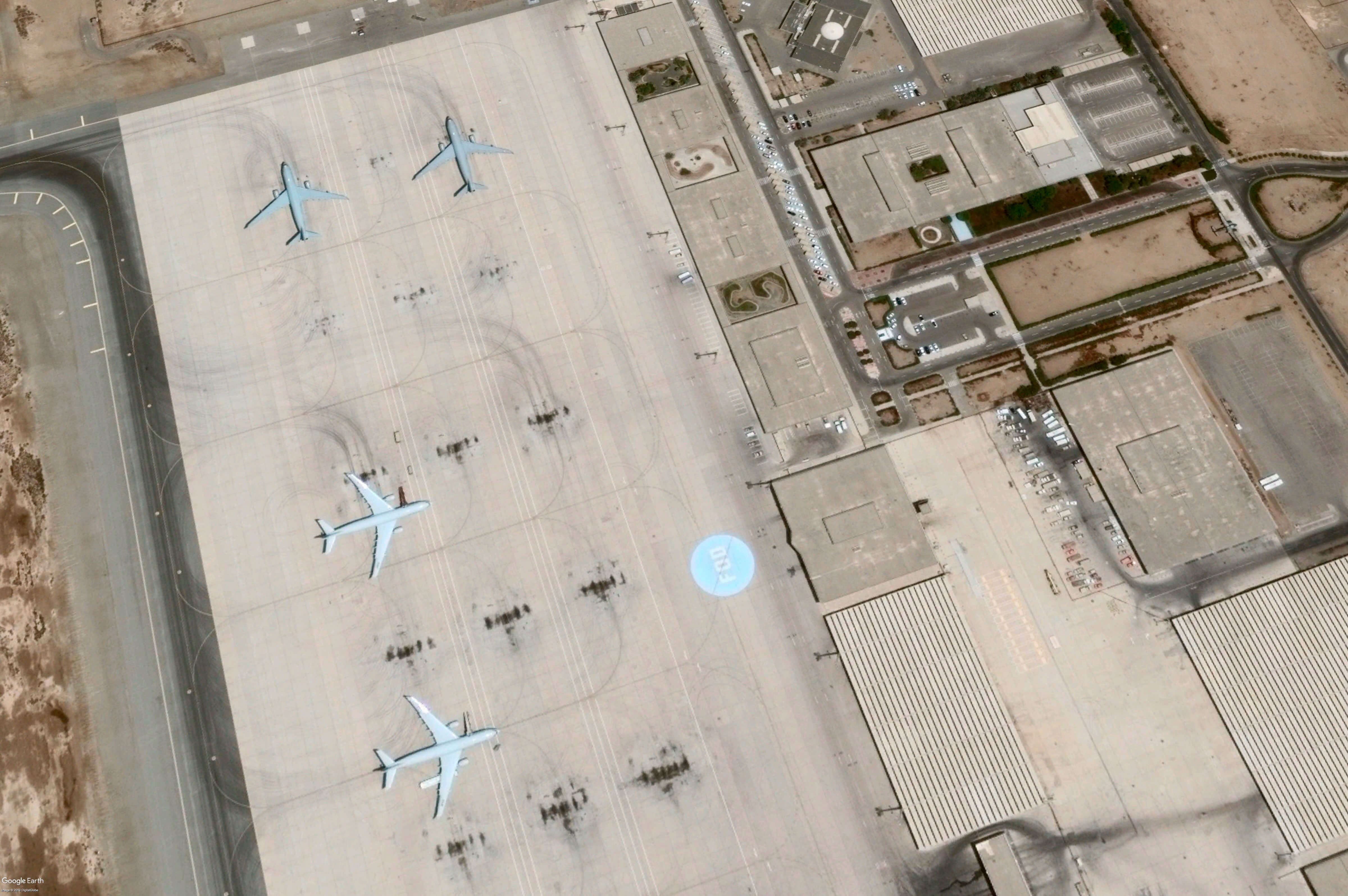
A satellite view dated June 2017 shows the presence of three A330 MRTT tanker aircraft in Jeddah, Saudi Arabia.
AS-532 Cougar multi-purpose military helicopters are deployed over Yemen from Saudi military bases in Khamis Mushait and Jizan.
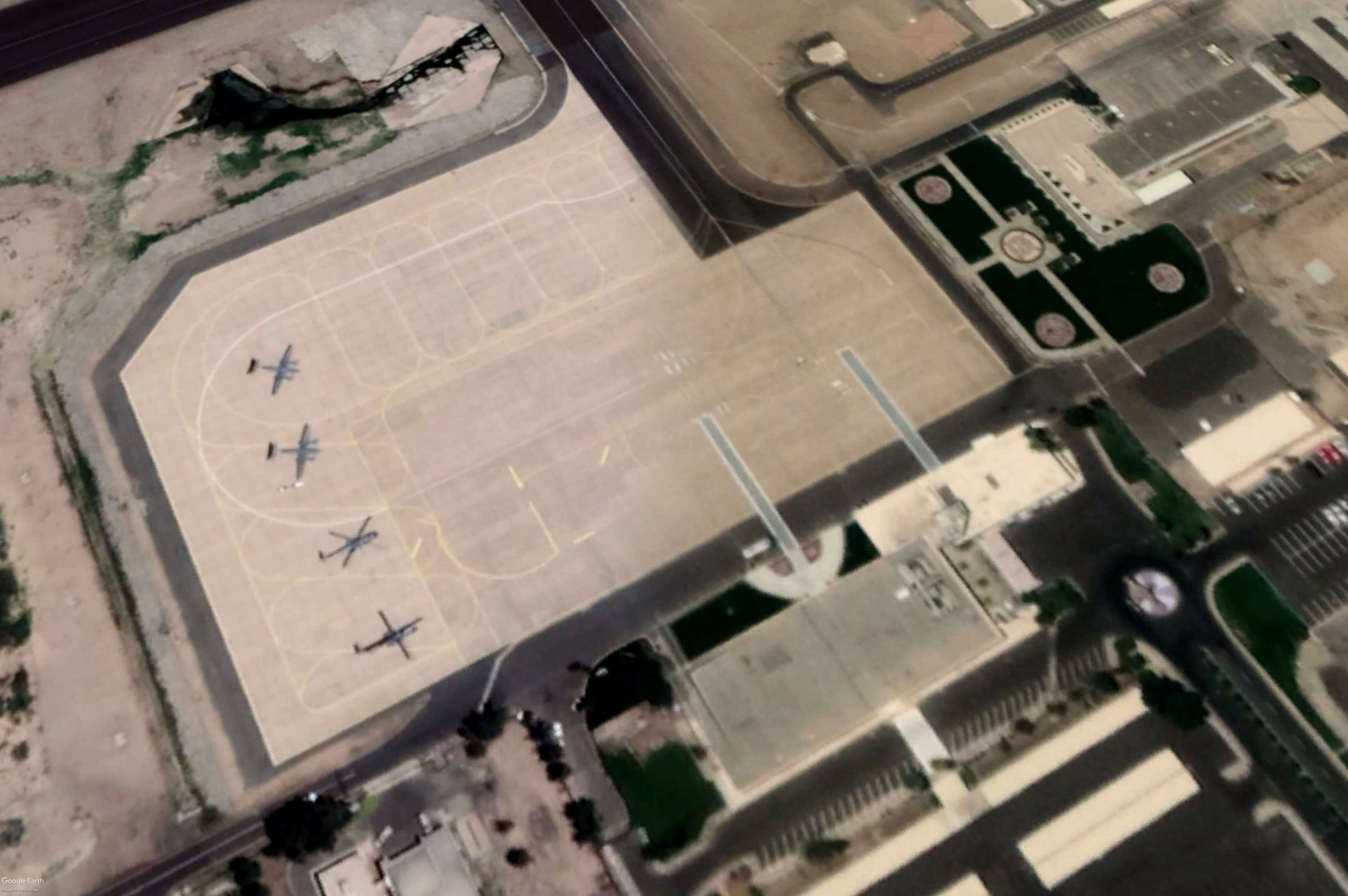
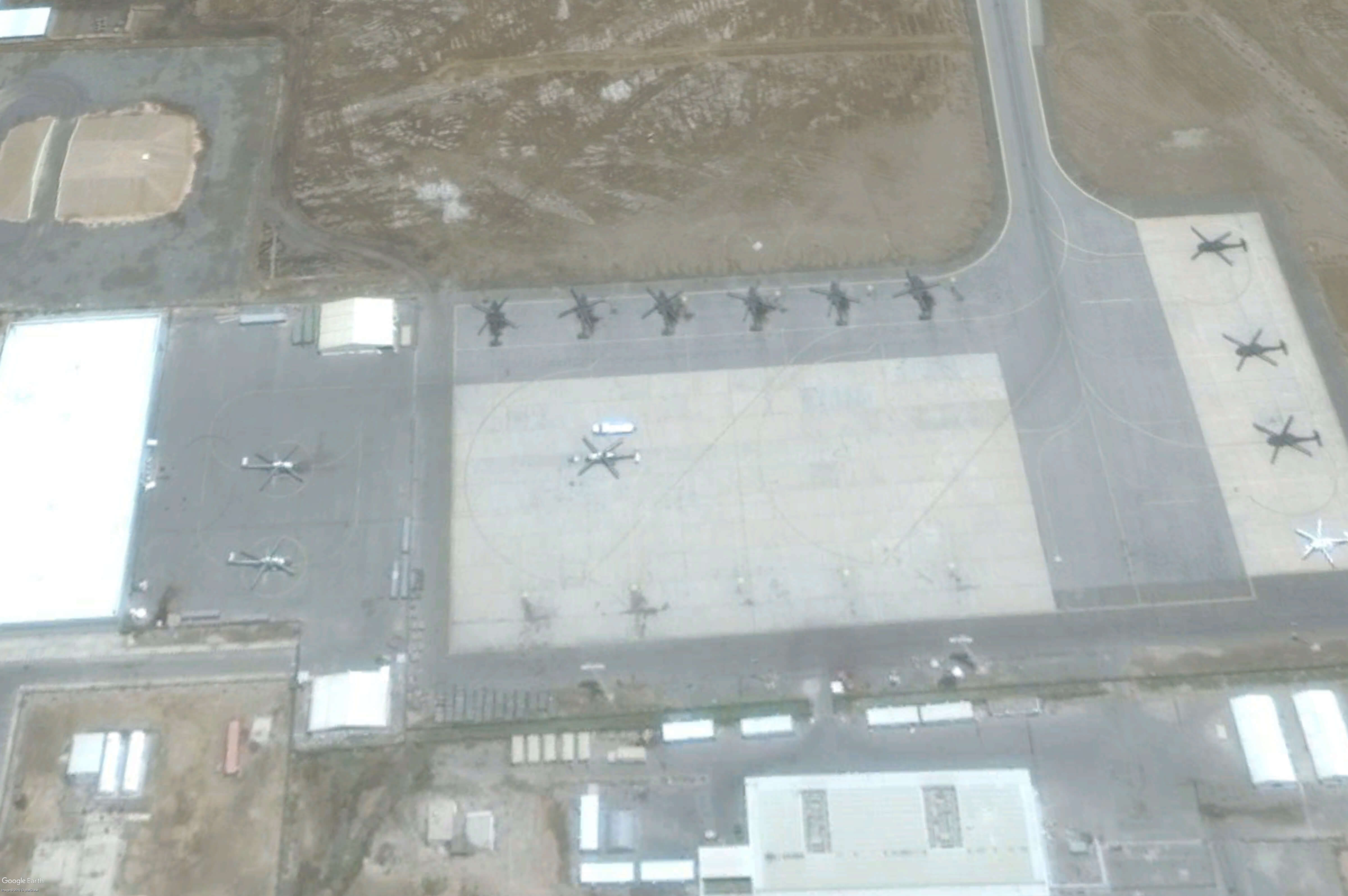
Satellite view of the Khamis Mushait and Jizan bases.
"It is priority for France that humanitarian aid can get through."
Since the spring of 2015, warships of the Saudi-led coalition have filtered access to Yemen’s Red Sea port of Hodeidah. Officially, the Saudi and Emirati navy vessels are enforcing a UN embargo against shipment of arms for Houthi forces, by carrying out an inspection of onboard cargo deemed to be suspicious. But in reality, they are blocking supplies of food, fuel and medicines destined for more than 20 million Yemenis. The blockade “has denied entry to vessels on a seemingly arbitrary basis” concluded a report by the UN office of the High Commissioner for Refugees (UNHCR) published in August 2018.
By publicly announcing that the ending of the Red Sea blockade of shipping was a “priority” for the French government, France’s defence minister Florence Parly overlooks an essential point, about which she was informed by the DRM report: two French-made warships “take part in the naval blockade” which is starving millions of Yemenis (see ‘The war of starvation’). The warships are the Al-Ryadh-class (derivative of the La Fayette-class) frigate Makkah for the Saudi Royal Navy, and a missile-launching Baynunah-class corvette belonging to the UAE navy. According to the DRM report, the latter is part of “support for terrestrial operations carried out on Yemeni territory”. In short, the corvette takes part in shelling the Yemeni coast.
The following photo shows the French-made ships moored at the Assab port in Eritrea on November 21st 2018.
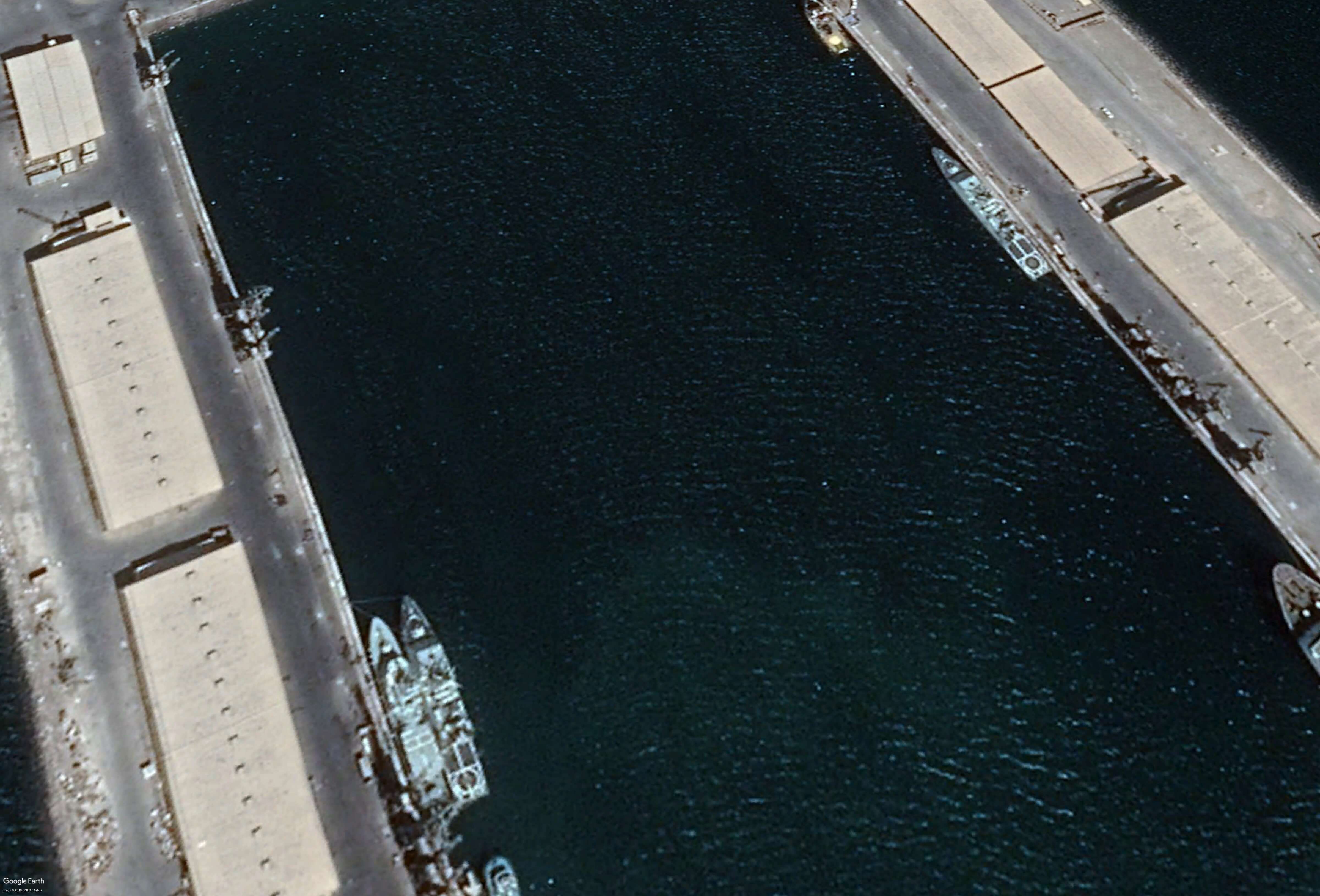
At the end of 2017, amid the war in Yemen, the UAE placed firm orders for two French-built Gowind 2500 corvettes. French President Emmanuel Macron, announcing the news at a press conference in Dubai on November 9th 2017 said: “This contract consolidates our relationship with the country in naval matters, and also completes a very strong cooperation we have had these past years regarding all these weapons.”
French commercial interests have placed it in a very contradictory situation. France is the world’s third-biggest exporter of weapons, and between 2008 and 2017 Saudi Arabia and the UAE were, respectively, its second and sixth biggest arms export markets, according to data from the French defence ministry. But France has also signed up to the UN Arms Trade Treaty (ATT), which imposes upon it, like all other signatories, the prohibition of “any transfer of conventional arms” if it has knowledge that they “would be used in the commission of genocide, crimes against humanity, grave breaches of the Geneva Conventions of 1949, attacks directed against civilian objects or civilians protected as such, or other war crimes.”
Meanwhile, how can it be established, once their trace is lost, whether weapons supplied by a country’s arms industry have been used against civilians?
The report by the DRM recognised that without information sources “in the zone” in Yemen it cannot be able “to measure in precise terms” the military arsenal engaged by the coalition. As to the quantity of French-made equipment that is deployed, the military intelligence agency simply admits that it has “no information” on their precise use in the conflict in Yemen, nor regarding their presence at the border. That is a very embarrassing confession for the French government, but which was – until now – protected by the information classified as “secret défense”.

